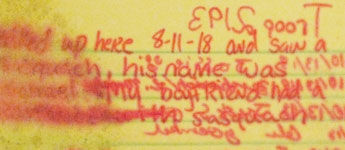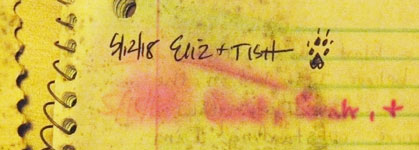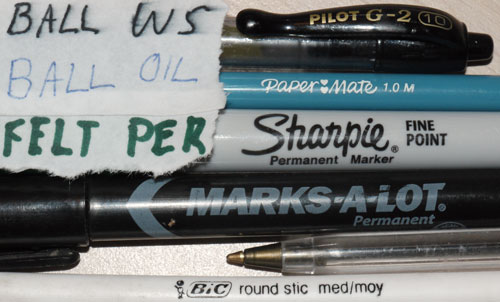Pinhoti Trail Log Books
Analysis and Comments
2006 - 2019
This is a work in progress, where I'm storing my ideas while typing the many logbooks. It will eventually contain my analysis of these many logs.
Dan Bedore's Comments, January 2020
Per a request from John Calhoun, I am studying as many registers as I can to document trends in use of the Pinhoti National Recreation Trail, which is located in northeastern Alabama and northwestern Georgia. The trail registers were typically kept in the camping shelters along the Pinhoti, except that the Flagg Mountain Register was kept in a kiosk along the access road ascending to and northwest of Flagg Mountain.
Range of Uses of the Pinhoti Trail
The point of this study is to determine how people use the trail, and how the use has changed over time. Use of the Pinhoti Trail includes a range from short day hikes through interstate multi-month hikes between Florida's Florida National Scenic Trail and the northeastern United States via the Appalachian National Scenic Trail, the Great Eastern Trail, or etcetera. The Pinhoti Trail is the only long hiking trail connecting northern Georgia and Alabama with points further south.
Request for Additional Logbooks
Since the Pinhoti is maintained almost entirely by volunteers, it is volunteers who buy these notebooks and place them in various trailhead kiosks and trail camping shelters. The registers often end up in the personal libraries of these volunteers. I feel this study will be most valuable if I study as many registers as possible. I request all who have filled-in registers to contact me, Dan Bedore, by email at danshike@yahoo.com. I could borrow the registers and return them, come and transcribe / study them in person, or the holder could photocopy, digitally scan, or photocopy the pages and send them to me. Or we can figure something else out. Please understand I visit Alabama a couple of times each year, so it may take a while before we can meet in person. Thanks!
By March 2020, I had collected and entered some 3,000 logbook entries, enough to get an excellent start on the analysis. I will continue to seek more log books, and add them. Once enough additional books are available to me, I will update the analysis results.
I also invite comment on what analysis ought to be done, etcetera. The email address above is the best way to contact me.
Editorial License in Transcription of Logs
• Plain Text is a fairly direct transcription of the journal.
• I changed dates to dd month yyyy format.
• I changed abbreviations to full words and made other small changes to make reading easier.
• F: Means a family.
• I'm guessing a small percentage of the hikers listed are dogs. I doubt it will affect the trends I hope to detect. Anyway, I like dogs and suspect they enjoy hiking too.
• Italic Text is my (Dan Bedore's) comment.
• I tried to preserve some symbols and art.
• 2 or more names, then a last initial implies the same surname
• The log book pages are self derived: in general, I did not do more research to correct them. Later analysis will incorporate cross comparison between logs and other research
• Overnight means the party camped somewhere along that hike, not necessarily in that shelter
• In general, the idea was to keep as much of the look and feel of each journal entry, while making them much more readable.
I hope the format I've chosen makes it easy for me and other people to read the logbooks and compare entries. I also hope it will make it easy to load all the books into a spreadsheet and sort all to compare similar entries and suss out trends. I suppose I would add new columns to help the sorting process. Perhaps I would sort by families, scouts, trip days, trip miles, etcetera.
Families
Scouts
Groups |
Miles/Day
Miles/Trip
Miles/Car |
Day
Overnight
Many |
First
Return
Long |
Ages
Quantity |
Religion
Philosophy
Quotes |
GET
ECT
Pinhoti |
Hiker
Hunter
Maintainer |
| Long Distance Hikers: |
G - Great Eastern Trail
E - Eastern Continental Trail
O - Other Long Route
P - Pinhoti Only
T - Training For Other LD Hike
1 - 1, 2, 3 # nights / Trip
|
|---|
| Families: |
S - Children
O - Other
C - Couples
|
|---|
| Groups: |
S - Scouts
O - Other
C - Church
U - University
|
|---|
| Maintainers: |
1, 2, 3 - Number of Maintainers
|
|---|
|
Damage to Notebooks
|
|---|
 Rodent Damaged Notebook
Rodent Damaged Notebook
Probably a rodent chewed away these pages to gather soft, insulating material for a nest. I have not noticed many food stains that would encourage eating of the notebooks. The books are usually stored in plastic bags, which are waterproof, but do not deter rodents. Some shelters have metal mailboxes, which are both water and rodent proof, but tend to collect random junk, and may lead to a messy shelter as people see the junk collection and contribute. Although a mailbox ought to restrict animals and falling water, there ought to be enough ventilation to allow wet books to dry, and drain holes if water can pool in the bottom. Holes might need to be drilled in strategic spots.
Also note the dark Mildew Stain in the upper left corner.
|
 Deliberately Torn Book
Deliberately Torn Book
Someone has torn pages from the back of this stitched composition book for notes, fire starting, toilet duty, etcetera.
|
 Deliberately Torn, Binding Disintegrating
Deliberately Torn, Binding Disintegrating
Here, pages in the back were torn out all the way to the stitching of the binding. Many pages in the front are completely loose, with just a few holding on where the ripping in the back was not all the way to the binding.
|
 Stains
Stains
In a few cases, there is non-mildew droplet staining. Maybe the shown brown stains are from something like coffee, but there are also red or blue stains probably from ink.
|

 Two Examples of the Printed Lines Dissolving Due to a Wet Book
Two Examples of the Printed Lines Dissolving Due to a Wet Book
Even so, the pen ink was not water soluble and remained legible.
Note that "April 1 group" was written in charcoal. Perhaps all the pens were missing or dead.
|
 Water Soluble Ink
Water Soluble Ink
Note that some writing is mirror image. This page got wet and writing on both sides bled through, rendering some writing nearly illegible due to double image. To the left, writing is more illegible because the page was wet longer and the ink bled until the lines were totally out of focus. Also, there is some light mildew staining.
|
 Water Dissolved Ink, Mildew, Torn Cover
Water Dissolved Ink, Mildew, Torn Cover
The red, water soluble ink is mostly illegible, while the black, oil ink is well preserved. Writing in pencil is very light but still sharp and legible with enough light. The page is mildewing, and the cover is torn where the water weakened the binding.
Although the shown cover is only partly torn away due to water damage, in some cases helically wound wire bound covers are ripped away probably due to careless handling. They are usually stored with the rest of the notebook.
|
|
Recommendations on Books and Pens
Unfortunately, if we were to provide expensive waterproof pens or books, I think they would disappear quickly.
Paper Books
Running of the printed lines in cheap books does not badly affect readability. Buying cheap books is probably the way to go.
Pencils
We can, however, control the types of pens or pencils used by taking bleeding types and pencils away and supplying cheap ball point pens. Pencils don't bleed, but the writing is often very light or the pencils are not sharp. Believe me when I say that these books are hard enough to read already. Let's not encourage pencil use.
Pens
It often says on the side of a felt marker whether it is permanent or will come out in the wash. Ball point pens are not usually marked regarding the water solubility of the ink. The best thing to do is a quick test. If you write on a bit of paper and pour some water over it, water soluble ink will begin to bleed right away, and oil ink will not. Most of the cheapest ball point pens have the oil ink that won't bleed. If a maintainer plans to visit a shelter, they could bring a few non-bleeding pens. They could try the pens in the shelters and haul away any bleeders.

Pens and Ink Solubility in Water
I wrote on this bit of paper and poured water over it for a moment.
Top: For this Pilot G-2 10 ball point pen, the ink ran right away.
The Papermate ball point ink did not run.
The Sharpie and Marks-A-Lot are marked permanent and did not run.
The bottom two Bic pens do not run.
|
Wet Books
I don't know what we can do about mildewy old registers. While it's a great idea to keep a dry book in a waterproof bag or other container, sealing up a wet book encourages rot and ink bleeding. If you visit a shelter and find a wet book, open it to the wettest part and leave it to dry in the dryest area of the shelter, holding it and its bag down with stones.
Replacing Damaged Books
If a book is starting to look torn up, let everyone know so it can be replaced as soon as possible. A book that looks junky is one that will be further abused. And torn pages will start to disappear.
Replacing Filled Books
When a book is full, people start squeezing their entries wherever they find leftover space. The writing gets less legible and out of sequence. A nearly full book should be replaced and archived.
Leaving Books in the Shelters
There is always a conflict between keeping the registers in the shelters because visitors enjoy reading what others have written, and replacing / taking the books so they can be archived and studied. Let's try to leave them so long as they are in good shape and have plenty of space.
Placing Historic Logs in the Shelters
Once I have these journals transcribed, I could laser print them, have them bound, and place them in their shelters. In a 30,000 mile hiking career, I think I have seen this exactly once. But again, I have often seen hikers poring over ancient entries, so I think they would like it.
Ideas for Printed Logs
To avoid water damage / ink bleeding, these printed journals ought to be laser printed rather than ink jet printed. The covers ought to be a heavy cardboard rather than plastic so they would dry after getting wet. A loose binding like combs or helical wire / plastic would keep stress off the paper as people read.
Ideas for Printed Empty Log Books
I thought about printing an empty format like the tables I've made. There would be boxes for date, number of hikers, etcetera, above a large box for freeform writing, drawing etcetera. I think it ought to be a separate book from the historical printouts to limit handling damage to the books. I think they might not be as tough as store bought cheap notebooks. They would make transcribing easier. But they might limit the creativity of the hikers and make each entry less individual. I'm undecided and pondering...
Ideas for Soliciting Thoughts on Specific Topics
I've noticed that if a specific question is asked, or a specific subject is raised, others read back a few entries and often write on the same topics. So if one wanted opinions on something, asking or just writing about that subject would probably generate useful comments.
Thanks
Dan
|
Intended Analysis
Long Distance Hikers
A list of long distance hikers, including entries in various logs, and any information we can find on the success of their extended journeys along the ECT, GET, etcetera. Even hikers who who attempted much of the Pinhoti ought to be included.
For each shelter, mileages within a day or two's walk might be listed. This might be in a simple map format. The map would have to be good enough to plan and dream to, but not useful for hiking, or it would disappear. Graphs of hikers per year over many years, including day vs Pinhoti thru, ECT, GET, etcetera would illustrate long term trends. Within each year are busy spring and fall seasons, and lonely winter and summer seasons: these ought to be graphed also.
Versus Master Plan Survey
An on line survey was conducted by Alabama Trails Foundation, ArchitectureWorks, & MacKnally Land Design for The Alabama Pinhoti Trail
Built Environment Master Plan in 2019. It would be interesting to derive comparable numbers and see how they line up. The Plan Survey included hiker ages, visits per year, party size, distance of travel, and type of trail use.
| Master Plan Survey
|
Comparable Data From Shelter Logs
Thoughts after transcribing three log books
|
|---|
| Ages |
|---|
| <19 | - |
| 19-24 | 9.6% |
| 25-34 | 12.7% |
| 35-44 | 21.0% |
| 45-54 | 31.8% |
| 55-64 | 24.2% |
| 65+ | - |
| 157 Responses |
|
The logs don't contain much age data.
|
| Visits per year |
|---|
| Never | 10.2% |
| 1-3 | 37.6% |
| 4-6 | 20.4% |
| 7-9 | 8.9% |
| 10-12 | 5.1% |
| 12+ | 17.8% |
| 157 Responses |
|
It may be possible to sort the log data and get a fair idea of visits per year.
|
| Party Size |
|---|
| 1 | 26.5% |
| 2-3 | 48.4% |
| 4-5 | 18.1% |
| 6+ | 7.1% |
| 155 Responses |
|
Almost all entries show a party size.
|
| Travel Miles |
|---|
| >5 | 12.2% |
| 5-20 | 18.6% |
| 20-50 | 20.5% |
| 50-100 | 32.7% |
| >100 | 16.0% |
| 156 Responses |
|
Hometowns are listed in the Flagg log, but not the Oakey or Lower Shoal logs I've transcribed so far.
|
| Trail Use |
|---|
| Day Hikes | 73.9% |
| Overnights | 62.1% |
| Thru Hikes | 13.7% |
| Running | 13.9% |
| 153 Responses |
|
Day vs Overnight and Thru hikes will be easy. Of 3 books, only the Lower Shoal book has been signed by runners.
|
John Calhoun's Book Inventory
John N Calhoun 21 October 2019
Blue Mountain Shelter
20 January 2007 → 25 May 2009
5 April 2009 → 16 July 2010
Missing: July 2010 → November 2013
16 December 2013 → 9 April 2016
30 July 2016 → 12 May 2018
Note: Probably needs new Logbook
Lower Shoal Shelter
24 March 2014 → 4 August 2016
August 2106 → November 2017
Laurel Shelter
April 2006 → October 2007
Missing: November 2007 → February 2010
March 2010 → 17 June 2014
June 2014 → August 2019
Choccolocco Shelter
23 March 2010 → 22 January 2012
28 January 2012 → 19 April 2014
June 2014 → April 2016
Note: As of 18 October 2019, Log Book is missing.
North Dugger Shelter
6 March 2010 → 29 June 2014
29 October 2014 → 3 November 2017
12 November 2017 → 19 October 2019
Oakey Mountain Shelter
14 November 2013 → 17 November 2017
 Rodent Damaged Notebook
Rodent Damaged Notebook Deliberately Torn Book
Deliberately Torn Book Deliberately Torn, Binding Disintegrating
Deliberately Torn, Binding Disintegrating Stains
Stains
 Two Examples of the Printed Lines Dissolving Due to a Wet Book
Two Examples of the Printed Lines Dissolving Due to a Wet Book Water Soluble Ink
Water Soluble Ink Water Dissolved Ink, Mildew, Torn Cover
Water Dissolved Ink, Mildew, Torn Cover